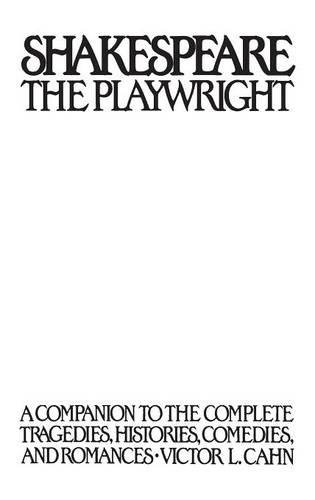
Shakespeare the Playwright: A Companion to the Complete Tragedies, Histories, Comedies, and Romances
(Hardback)
Available Formats
Publishing Details
Shakespeare the Playwright: A Companion to the Complete Tragedies, Histories, Comedies, and Romances
By (Author) Victor L. Cahn
Bloomsbury Publishing PLC
Greenwood Press
12th March 1991
United States
Classifications
Tertiary Education
Non Fiction
Literary studies: c 1600 to c 1800
822.33
Physical Properties
Hardback
888
Width 156mm, Height 235mm
1389g
Description
Since their first production four centuries ago, the plays of William Shakespeare have been widely produced and examined. In this book, Victor Cahn guides the reader scene by scene through each of Shakespeare's 37 plays, in an attempt to recreate the freshness and theatrical effect of performance. He has based his approach on the assumption that the fundamental appeal of Shakespeare's plays lies in the characters and he focuses on how the implications of the characters' actions and the nuances of their language contribute to the plays' impact. The introduction briefly traces Shakespeare's life and career and explains some of the social and artistic circumstances that influenced his work. The plays are grouped by genre - tragedies, histories, comedies and romances. This structure allows Cahn to explore Shakespeare's development in all four dramatic forms, as well as to suggest relationships between characters, themes and images throughout the works. In addition, Cahn discusses the plays as reflective of Shakespeare's age, particularly the Renaissance concern with the tension between individual rights and social responsibility. The text is free from extensive scholarly apparatus, but suggestions for further reading follow the analysis of each play and a selected bibliography concludes the volume.
Reviews
A useful guide for the general reader, as well as high school and undergraduate students, to Shakespeare's 37 plays. After a brief introduction outlining Shakespeare's life and career, Cahn carefully guides the reader through each play in turn, from first scene to last, using a mixture of quotation, paraphrase, and critical comment. His style is accessible and unpretentious, and his insights into the 'psychological consistency' of Shakespeare's characters-the main focus of the commentary-are stimulating and sometimes provocative. The bibliographies at the end of each chapter, and at the end of the volume, provide a guide to further study for the nonspecialist.-Library Journal
Contending that the fundamental appeal of Shakespeare's work lies with his characters, Cahn systematically proceeds through a discussion of each play (within the traditional categories of tragedy, history, and romance) as if an audience were encountering that play for the first time. The chapters explain how the plays succeed as theater and how the subtleties of the characters' behavior and the nuances of their language contribute to the theatrical effect. This critical appreciation approach differentiates Cahn's "companion"/handbook from other Shakespeareana--The Shakespeare Handbook, ed. by Levi Fox (1987) and Charles Boyce's Shakespeare A-Z (CH, Apr'91)--in which the intention is to assemble a body of Shakespearean lore for information. In Cahn's work, suggestions for further reading (usually a short list of the prominent, old studies) follows each analysis. Two appendixes (The Two Noble Kinsmen) and a who's who of the "Royal Figures" are provided. A one-page select bibliography, a character index, and a general index end the book. It is highly recommended for any general public library and for academic collections at all undergraduate levels.-Choice
In his discussion of each play, Cahn, writing for a general (albeit intent) audience, bases his approach on the assumption that the fundamental appeal of Shakespeare's plays lies in the characters. He focuses on how the implications of the characters' actions and the nuances of their language contribute to the plays' impact.-Reference & Research Book News
"A useful guide for the general reader, as well as high school and undergraduate students, to Shakespeare's 37 plays. After a brief introduction outlining Shakespeare's life and career, Cahn carefully guides the reader through each play in turn, from first scene to last, using a mixture of quotation, paraphrase, and critical comment. His style is accessible and unpretentious, and his insights into the 'psychological consistency' of Shakespeare's characters-the main focus of the commentary-are stimulating and sometimes provocative. The bibliographies at the end of each chapter, and at the end of the volume, provide a guide to further study for the nonspecialist."-Library Journal
"In his discussion of each play, Cahn, writing for a general (albeit intent) audience, bases his approach on the assumption that the fundamental appeal of Shakespeare's plays lies in the characters. He focuses on how the implications of the characters' actions and the nuances of their language contribute to the plays' impact."-Reference & Research Book News
"Contending that the fundamental appeal of Shakespeare's work lies with his characters, Cahn systematically proceeds through a discussion of each play (within the traditional categories of tragedy, history, and romance) as if an audience were encountering that play for the first time. The chapters explain how the plays succeed as theater and how the subtleties of the characters' behavior and the nuances of their language contribute to the theatrical effect. This critical appreciation approach differentiates Cahn's "companion"/handbook from other Shakespeareana--The Shakespeare Handbook, ed. by Levi Fox (1987) and Charles Boyce's Shakespeare A-Z (CH, Apr'91)--in which the intention is to assemble a body of Shakespearean lore for information. In Cahn's work, suggestions for further reading (usually a short list of the prominent, old studies) follows each analysis. Two appendixes (The Two Noble Kinsmen) and a who's who of the "Royal Figures" are provided. A one-page select bibliography, a character index, and a general index end the book. It is highly recommended for any general public library and for academic collections at all undergraduate levels."-Choice
Author Bio
VICTOR L. CAHN is Professor of English at Skidmore College. He teaches courses in Shakespeare and modern drama and is the author of four books and several plays. His numerous articles and reviews have appeared in such diverse publications as Modern Drama, The Literary Review, The New York Times, and Variety.
